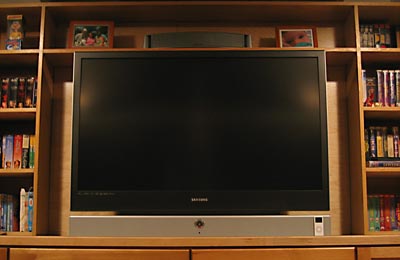Post WE05: Manly Jazz
Published 20 years, 1 month pastOn the Saturday after WE05 concluded, I took the ferry over to Manly Beach with Doug, Kelly, and Erik. It just so happened that the Manly International Jazz Festival was being held that weekend, and with weather so beautiful and clear, it was impossible to resist heading over. Once we got there, I kept snickering to myself at all the localized signs; I simply could not resist repeating them in a deep, booming voice: “MANLY T-Shirts! MANLY Boatshed! MANLY Frozen Custard! MANLY Ocean Foods! C’mon, try some! It’s MANLY!”
As a result, I got curious about the origin of the name, so I asked a couple of locals. According to them, the beach got its name because the aborigines who lived there were very manly, and enough so that the invaders gave the cove that name. This, to me, sounded like the kind of jokey answer you give foreigners to find out how gullible they are, but if that’s the case, then it’s a joke they tell to each other as well.
The first act we caught was a Dixieland quartet that was filling time between stage acts. I thought they were pretty good, especially considering they were all playing to a single microphone. Then we saw Peter Ind from the UK, as well as some of his supporting players, The Ozboppers. At least two of which were from America, but never mind that now. Mr. Ind was really very good, but I took one look at him, turned to Kelly, and said, “Ladies and gentlemen—Gandalf on the bass.”
Seriously, that’s what it looked like. I guess he would need a new gig after Sauron’s defeat.
Wandering onward, we stumbled across a small side-street stage where this absolutely incredible singer was belting out some jazz standards. I was transfixed. I mean, not only did she have this whole “hot librarian” look going, but her voice was simply unbelievable. I can’t even properly characterize it, but my best attempt is the smoky expressiveness of Billie Holiday combined with the range of Ella Fitzgerald and the nimbleness of Anita O’Day.
It turned out we were listening to Elana Stone, who continued to transfix me and everyone around her through a few more numbers. Afterward, I bought a CD (“In The Garden of Wild Things”, which she signed for me) and tried not to be too much of a gushing fanboy. If Ms. Stone doesn’t become a major star, it will be a crime, although a part of me thinks that she was born several decades too late. Had she been singing in the 1930s and 1940s, she would have been a sensation; her name would be up with those I mentioned previously. I have this fear that her voice won’t have as big an audience as it should in the 21st Century. At the same time, I very much hope that fear is misplaced.
The ferry ride back to Sydney was illuminated by a perfect (if cloudless) sunset and a dusky gloaming sky behind the Sydney Harbour Bridge, and marred by a terribly assembled Elvis impersonator and his even scruffier companion singing a number of Western ballads rather gratingly off-key, and twice nearly brained me with their guitar’s tuning pegs. Even without the contrast with Ms. Stone, they would have been bad; so soon after hearing her, they were just short of abominable. I’d have said something, except they appeared to be rather soused, and I try not to tangle with pickled Elvis impersonators unless there’s life and limb at stake. It’s just one of my little guidelines in life.
Fortunately, the remainder of the evening was redeemed by a fine dinner overlooking Darling Harbour with assorted speakers and conference staff, great conversation about web design work and Australia going late into the night, and a leisurely walk back to the hotel with a friend.
Overall, a lovely day.
